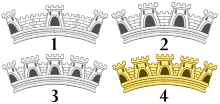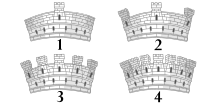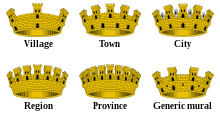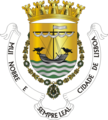
Tyche was the presiding tutelary deity who governed the fortune and prosperity of a city, its destiny. In Classical Greek mythology, she is usually the daughter of the Titans Tethys and Oceanus, or sometimes Zeus, and at this time served to bring positive messages to people, relating to external events outside their control.
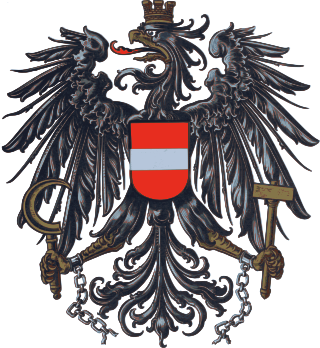
The current coat of arms of the Republic of Austria has been in use in its first forms by the First Republic of Austria since 1919. Between 1934 and the German annexation in 1938, the Federal State used a different coat of arms, which consisted of a double-headed eagle.
The Naval Crown was a gold crown surmounted with small replicas of the prows of ships. It was a Roman military award, given to the first man who boarded an enemy ship during a naval engagement.

The coat of arms of Belgrade is the official symbol of the City of Belgrade and is stable in three levels - as Basic or Small, Medium and Large.

Mitcham was a local government district in north east Surrey from 1915 to 1965 around the town of Mitcham.

The emblem of the Italian Republic was formally adopted by the newly formed Italian Republic on 5 May 1948. Although often referred to as a coat of arms, it is an emblem as it was not designed to conform to traditional heraldic rules. The emblem is used extensively by the Italian government.
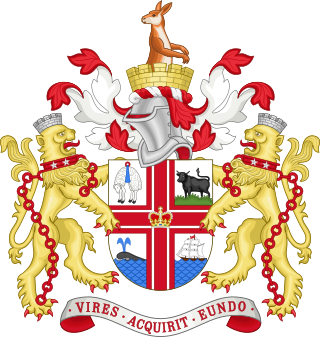
The coat of arms of the city of Melbourne, also known as the armorial bearings, is an official symbol of the City of Melbourne, Australia. They were granted to the corporation of the city by letters patent on 30 January 1940.

Portuguese heraldry encompasses the modern and historic traditions of heraldry in Portugal and the Portuguese Empire. Portuguese heraldry is part of the larger Iberian tradition of heraldry, one of the major schools of heraldic tradition, and grants coats of arms to individuals, cities, Portuguese colonies, and other institutions. Heraldry has been practiced in Portugal at least since the 12th century, however it only became standardized and popularized in the 16th century, during the reign of King Manuel I of Portugal, who created the first heraldic ordinances in the country. Like in other Iberian heraldic traditions, the use of quartering and augmentations of honor is highly representative of Portuguese heraldry, but unlike in any other Iberian traditions, the use of heraldic crests is highly popular.

The tradition and art of heraldry first appeared in Spain at about the beginning of the eleventh century AD and its origin was similar to other European countries: the need for knights and nobles to distinguish themselves from one another on the battlefield, in jousts and in tournaments. Knights wore armor from head to toe and were often in leadership positions, so it was essential to be able to identify them on the battlefield.

The Municipality of Ohrid is a municipality in the southwestern part of North Macedonia. Ohrid is also the name of the city where the municipal seat is found. Ohrid Municipality is in the Southwestern Statistical Region.

The London County Council was granted a coat of arms in 1914 and a heraldic badge in 1956. The coat of arms can still be seen on buildings constructed by the council before its abolition in 1965.

Italia turrita is the national personification or allegory of Italy, in the appearance of a young woman with her head surrounded by a mural crown completed by towers. It is often accompanied by the Stella d'Italia, from which the so-called Italia turrita e stellata, and by other additional attributes, the most common of which is the cornucopia. The allegorical representation with the towers, which draws its origins from ancient Rome, is typical of Italian civic heraldry, so much so that the mural crown is also the symbol of the cities of Italy.

A crown is often an emblem of a sovereign state, usually a monarchy, but also used by some republics.
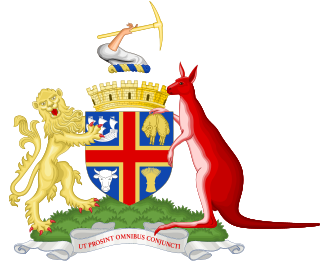
The coat of arms of Adelaide was granted by the Heralds' College on 20 April 1929.

National symbols of Italy are the symbols that uniquely identify Italy reflecting its history and culture. They are used to represent the Nation through emblems, metaphors, personifications, allegories, which are shared by the entire Italian people.

The coat of arms of the London Borough of Camden were granted on 10 September 1965. The borough was formed by the merger of three former boroughs, namely the Metropolitan Borough of Hampstead, the Metropolitan Borough of Holborn and the Metropolitan Borough of St. Pancras, from whose arms elements were utilised in the arms of the new borough.
In Ancient Rome, a camp crown, also known as a vallary crown, was a military award given to the first man who penetrated into an enemy camp or field during combat. It took the form of a gold crown surmounted with replicas of the stakes of a palisade.
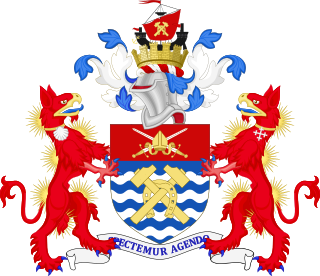
The coat of arms of the London Borough of Hammersmith and Fulham was granted to the then London Borough of Hammersmith on 1 March 1965, but the motto changed languages in 1969. The subsequent change of names to Hammersmith and Fulham on 1 January 1980 did not affect the arms.
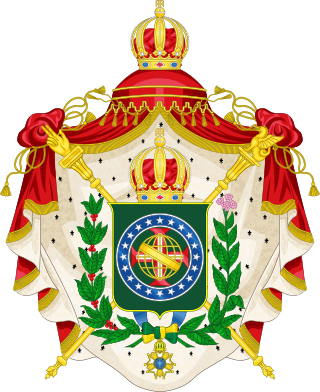
Brazilian heraldry as a distinct form of heraldry dates to 1822, when Brazil became independent as an Empire, under the reign of the House of Braganza. Being formerly a part of the Portuguese Empire and being ruled by the same Royal House that reigned in Portugal, Brazilian heraldry followed the tradition of Portuguese heraldry.

The coat of arms of Lyon, the ancient capital of the Gauls, reflects the rich history of the city across different periods of its existence and the power that has exercised authority over the city. It was created in 1320, although the current version, which dates from 1859, reprises the form that it had before the end of the Ancien Régime after having undergone several temporary modifications.




